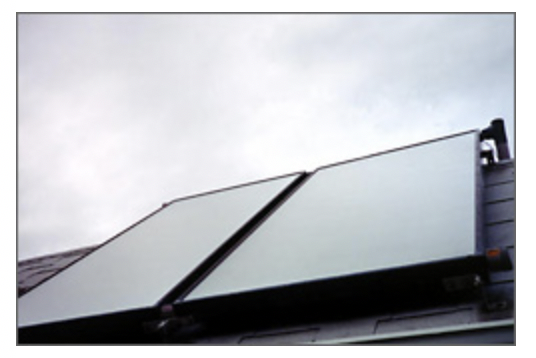Solar Thermal Systems
New ResidentialWhat are Solar Thermal Systems?
Solar thermal systems, whether passive or active, utilize solar power to heat water for domestic or process uses. In the residential sector, this often includes domestic hot water heating for inside the home or for heating a pool. Solar thermal water heating systems use insulated storage tanks and solar collectors that provide for up to 40 – 70% of a home’s water heating needs.[1] Conventional storage water heaters or demand (tankless or instantaneous) water heaters provide backup for cloudy days and increased demand.
The most common types of solar collectors for residential uses include flat-plate collectors and integral collector-storage systems. Flat-plate collectors consist of insulated and weatherproof boxes with a dark absorber plate under glass or plastic covers that heat water. Integral collectors use the same system as a flat-plate collector, but the water continues to a traditional hot water tank, ensuring a consistent supply of hot water.

Figure 1- Rooftop flat-plate solar collector (Source: National Renewable Energy Laboratory)
How to Implement Solar Thermal Systems
There are several factors to consider before installing a solar thermal system. First, look for opportunities to reduce hot water consumption such as installing water-saving devices like low-flow showerheads, faucet aerators, and water-efficient appliances to help reduce the size of the solar thermal system. [2] Variables include location, space, energy costs, available project incentives, sizing and design of solar thermal systems.[3]
Contact the NJ Office of Clean Energy to learn about current programs, tools, and available funding for residential solar thermal systems.
Hire an experienced solar thermal system installer, certified by the North American Board of Certified Energy Practitioners (NABCEP) to properly site and size the thermal solar system in coordination with standard plumbing trade work.
Example
Wisdom Way Solar Village (WWSV), Greenfield, MA.
This example describes the results of installing indirect solar water heaters in a development of 20 energy-efficient homes:[4]
- Total installed cost: $9,600
- System efficiency of 67%
- Annual energy savings: $134
Benefits
Solar thermal systems reduce greenhouse gas emissions, protect against the fluctuating costs of fossil fuels, and save on purchasing energy from utility companies while providing additional ecological and user benefits. Solar thermal systems reduce water consumption as well as the consumption of consumable, non-renewable, and often non-domestic energy sources such as natural gas.[5]
Costs
Solar thermal systems prove most cost-effective in locations with a consistent demand for hot water and high electric or natural gas prices. Solar thermal systems cost more upfront than conventional water heating systems but usually pay for themselves through annual energy savings of 50-80% compared to conventional systems.[6] While costs vary depending on the size of the system, type of system chosen, location, and contractor, for an average sized home, a system may cost between $7600 and $10,000.[7]
State and federal incentives are also available, which can significantly reduce the installation cost of a solar hot water system. See the New Jersey Clean Energy Program Water Heater rebate program for more information: http://www.njcleanenergy.com/residential/programs/warmadvantage/gas-water-heaters
Resiliency
Solar water heaters offer energy system resiliency in that they can provide hot water needs without a need for electricity or natural gas when installed with additional hardware—including transfer switches, critical load panels, and appropriate controls.
[1] Whole Building Design Guide (WBGD). Solar Water Heating. http://www.wbdg.org/resources/swheating.php (accessed April 20, 2018).
[2] US DOE. Reduce Hot Water Use for Energy Savings. https://www.energy.gov/energysaver/water-heating/reduce-hot-water-use-energy-savings (accessed April 20, 2018).
[3] US Dept of Energy’s (DOE) Federal Energy Management Program (FEMP). Guide to Integrating Renewable Energy in Federal Construction. https://www.wbdg.org/FFC/DOE/DOECRIT/re_construction_guide.pdf (accessed May 8, 2018).
[4] US DOE. Indirect Solar Water Heating in Single-Family, Zero Energy Ready Homes. https://www.nrel.gov/docs/fy16osti/65187.pdf (accessed April 20, 2018).
[5] Denholm, P. 2007. “The Technical Potential of Solar Water Heating to Reduce Fossil Fuel Use and Greenhouse Gas Emissions in the United States.” National Renewable Energy Laboratory, Golden CO. https://www.nrel.gov/docs/fy07osti/41157.pdf (accessed April 23, 2018).
[6] US DOE. Estimating the Cost and Energy Efficiency of a Solar Water Heater. https://www.energy.gov/energysaver/estimating-cost-and-energy-efficiency-solar-water-heater (accessed April 20, 2018).
[7] US EIA. Updated Buildings Sector Appliance and Equipment Costs https://www.eia.gov/analysis/studies/buildings/equipcosts/pdf/full.pdf (accessed April 20, 2018).
